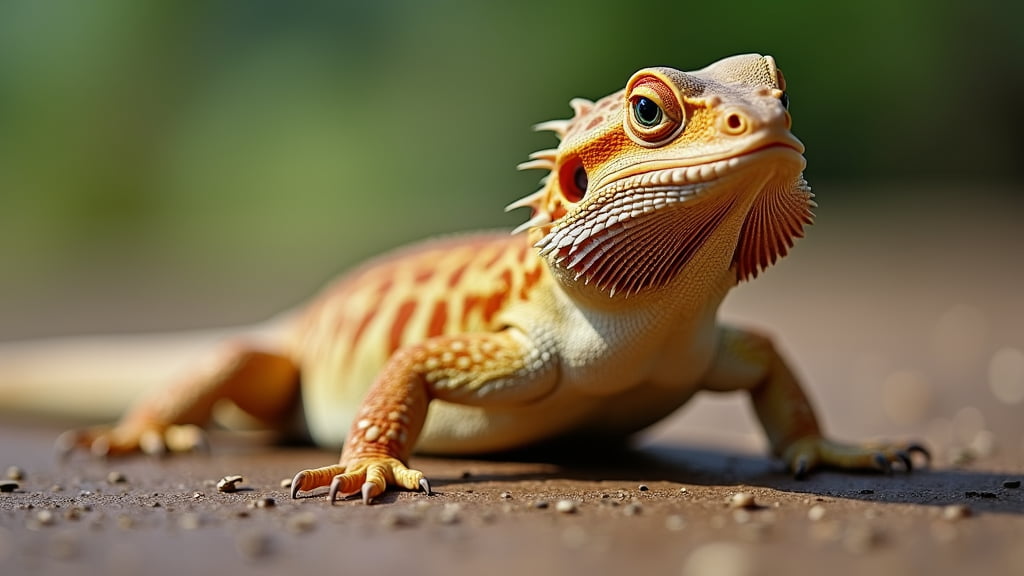Are you the proud owner of a bearded dragon or considering welcoming one into your home? One of the crucial aspects of their care is understanding bearded dragon activity levels. These fascinating reptiles have unique behaviours and energy patterns that are essential to their health and well-being. In this post, we’ll delve into the typical activity levels of bearded dragons, what influences their energy, and how you can ensure they remain active and healthy.
Daily Activity Rhythm
Bearded dragons are diurnal creatures, meaning their activity levels peak during the day. From my years of experience with these lovable reptiles, I’ve noticed distinct patterns influenced by various factors.
Morning Activity
Bearded dragons usually start their day with a basking session. After all, who doesn’t love a good sunbath? They typically position themselves under a heat lamp to warm up after a night’s rest. Warming up is crucial for bearded dragons as it helps regulate their metabolism and prepares them for the active day ahead. Observing your dragon’s behaviour during these morning hours can provide insight into their health. A lethargic dragon might need a check-up.
Afternoon Exploration
Once they’ve had their morning bask, bearded dragons tend to become more active. This period involves a lot of exploring, hunting for food, and interacting with their environment. Setting up an enriching habitat with climbing branches and hiding spots can encourage these natural behaviours. This phase is when your dragon will be most interactive, so it’s the perfect time for hand-feeding or letting them roam supervised outside their tank.
Evening Wind-Down
As evening approaches, bearded dragons begin to slow down. They often spend this time basking again, digesting their food, and eventually preparing to sleep. Ensuring your dragon has a consistent light-dark cycle mimicking a natural environment can help regulate these activity patterns and keep them healthy.
Factors Influencing Activity Levels
Several factors can influence the activity levels of your bearded dragon. Let’s explore these in more detail.
Age and Life Stage
- Hatchlings and Juveniles: Younger bearded dragons tend to be more active, expressing high energy levels as they grow. They love to explore and hunt, often spending more time moving around their enclosure compared to adults.
- Adults: As they mature, bearded dragons’ activity levels typically decrease. Adult dragons will still have active periods but may prefer to bask and rest more often.
- Seniors: Elderly bearded dragons can become significantly less active due to age-related health changes. Regular vet check-ups are vital to ensure these activity changes are due simply to ageing and not an underlying health issue.
Environmental Factors
- Temperature: Bearded dragons rely on external heat sources to regulate their body temperature. If the enclosure is too cold, your dragon may become lethargic. Conversely, too much heat can also lead to inactivity as they try to avoid overheating.
- Lighting: Proper UVB lighting is crucial for bearded dragons. Insufficient UVB exposure can lead to metabolic bone disease and other health issues, decreasing their activity levels.
- Habitat Enrichment: An enriched environment with various stimuli can encourage bearded dragons to stay active and engaged.
Seasonal Changes
Bearded dragons are known to experience brumation, a hibernation-like state during colder months. During brumation, your dragon might sleep for extended periods and eat less. It’s a normal behaviour, but monitoring their health during this time is essential.
Encouraging Healthy Activity Levels
A healthy bearded dragon is an active one. Here are some tips to ensure your reptile friend remains energetic and happy.
Provide Adequate Heating and Lighting
Ensure your dragon’s habitat has the appropriate heat gradient, with basking spots ranging from 38-42°C and cooler areas around 22-26°C. UVB lighting is essential for calcium metabolism and overall health. Replace UVB bulbs every six months for optimal performance.
Offer a Balanced Diet
A diet rich in nutritious insects, vegetables, and occasional fruit treats can keep your dragon healthy and energetic. Younger dragons require more protein for growth, while adults need a balanced mix of protein and vegetables.
Enrich Their Environment
Create a stimulating environment with rocks, branches, and hideouts. Interaction and playtime outside the tank can also provide mental and physical stimulation.
Monitor Health Regularly
Regular vet check-ups are essential to catch any health issues early. If your dragon exhibits drastic changes in activity levels, consult a vet promptly.
Conclusion
Understanding and monitoring your bearded dragon’s activity levels is key to providing them with a healthy and enriching life. By paying attention to daily rhythms, recognising the factors that influence activity, and taking steps to encourage healthy behaviour, you can ensure your scaly friend thrives.
Be sure to explore our Bearded Dragon Care Guide for more comprehensive tips and insights. For external resources, websites like Reptile Magazine offer valuable information on reptile care.
For any specific health concerns, always consult a veterinarian to ensure the well-being of your pet. Happy dragon-keeping!

